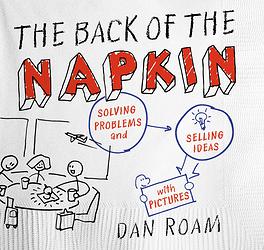Research shows these 3 elements are key to successful family business transitions
Recent News
Want to tackle a problem in business?
Draw a picture.
That simple but powerful approach to gaining clarity has led Dan Roam to become an international best-selling author.
 His signature work, “The Back of the Napkin: Solving Problems and Selling Ideas with Pictures,” which was named the innovation and creativity book of the year by Fast Company, Bloomberg Businessweek and The Times of London, and has been published in 27 languages.
His signature work, “The Back of the Napkin: Solving Problems and Selling Ideas with Pictures,” which was named the innovation and creativity book of the year by Fast Company, Bloomberg Businessweek and The Times of London, and has been published in 27 languages.
Roam and his whiteboard are frequent guests on CNN, NBC, ABC, CBS, Fox and NPR.
He will bring his expertise to Sioux Falls on April 11 and 12 as he kicks off the Prairie Family Business Association’s annual conference.
Roam shared with us how a picture truly can be worth 1,000 words.
What’s your backstory? How did you come to start taking this approach to tackling business problems?
Like everyone, I drew as a kid. Before we could read and write, pictures were our only means of recording our thoughts. But while most people stop drawing by second grade, I never gave it up. Of course, once I started going to business meetings, the fact that I drew made me a bit of a weirdo … but people understood my simple sketches more than most of each other’s words, so I have kept at it!
What is it that you think makes this approach to problem-solving so innovative?
More than half your brain is focused on processing vision – in fact, more of your brain is dedicated to processing vision than to any other thing that you do! But for most people, “vision” has become a passive process. But once you understand how vision works, you can hijack the process and quickly convey almost anything to anyone with just a couple simple pictures.
You contend it takes only six pictures to explain anything. What’s the science behind that?
Vision – your brain’s nearly miraculous act of turning light into meaning in your mind – is a process. And like any process, it can be modeled out, understood and optimized through practice. From a neuro-mechanical perspective, “sight” is composed of six primary “visual pathways,” each of which is responsible for processing specific types of incoming visual information. Once you know this, you can quickly learn to draw the six simple pictures that the mind is always looking for as it seeks to understand the world. Draw those six in order, and you can explain just about anything.
Family businesses face some unique challenges because of the relationship dynamics. Can they draw their way into solving those too?
I have done a lot of consulting work with family businesses, large and small. I consistently see two dominant needs: No. 1 is clarity in communications, and No. 2 is intentional focus on values and culture. Both those topics are helped enormously by creating clear and simple pictures that literally show what is it that people think, feel and need to share.
What’s the biggest takeaway people can expect from your presentation?
People involved in family business will see that simple pictures work magnificently as a fast way to share varied ideas and reach common ground. And people will see that creating those pictures is far simpler and more intuitive than they might think!
Silly, maybe, but critical question: If I have absolutely no artistic ability, will this still work for me?
Absolutely; although we will be drawing, this isn’t about art. Our objective is to use pictures to show clear thinking, not beautiful drawings. If you can draw a circle and a square, you are already a great visual thinker.





